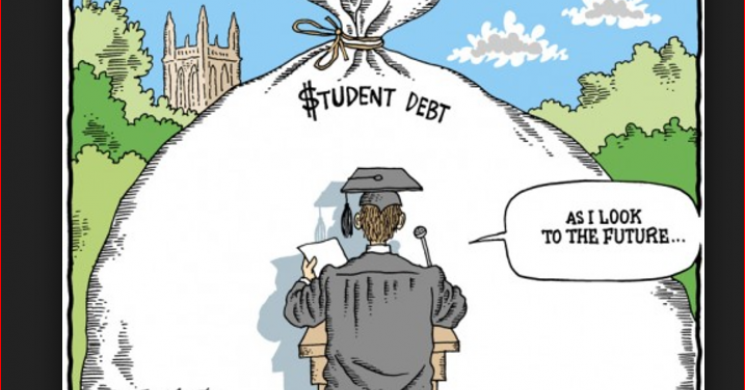
Student Loan Debt Problem Solved
College ain't what it used to be. And student loans are paving the way to indentured servitude possibly for the next generation.
In one admittedly cynical scenario we see in the future a large number of college graduates unable to repay student loans. We also see a government unable to disclose that default to thepublic and risk its own credit rating being downgraded.
Student Loan Breakdown in 2017
And we see in this dystopian future recent college graduates being offered deferment and forbearance on their loans if they take government jobs at ridiculously low wages. The deal offered would delay, pay down, or forgive their loans if they work for the US Gov't for 10 years.
And with one stroke, the US Government has solved unemployment and credit risk to itself. And they have done i t (again) on the backs of the working and middle class that some how still thinks the American dream is anything more than a dream.
Sound crazy? it is not. Think of the inverse scenario. Law firms and investment banks pay for your MBA if you sign on with them to work for a few more years. Why is it not logical for the US Government to offer jobs to pay for college.
A wise woman once said to us in 1983: "Don't get a degree in finance, drop out and get a skill like plumbing or be an electrician. She was so far ahead of the curve it was scary. And she was an executive at a bank when she said it.
(Dedicated to Vivian Stabile)
Student Loan Rates Spike
Via Grant's Interest Rate Observer
That walk to the graduation podium is set to get a little more expensive. Beginning on Saturday, July 1st, interest rates on new student loans will be set higher, to 4.45% on ten year debt from the 3.76% rate seen this year for undergraduate students, according to CNBC. Graduate lending rates are also moving north, to 6% as of July 1st from the prior year’s 5.31%.
The upward rate reset, which was established by the May 10 auction of 10-year U.S. Treasury notes, corresponds to a similarly higher yield in the 10-year compared to last year. Legislation signed in the 2013 Student Loan Fairness act tied interest rates to that 10 year Treasury. Christine DiGangi of credit.com explains the details:
Every year, the undergraduate loan rates are calculated by adding 2.05 percentage points to the high yield of the 10-year note at the last auction prior to June 1. Add 3.6 percentage points to the high yield to determine unsubsidized graduate loan rates, and for PLUS loans, add 4.6 percentage points.
That the sting of higher borrowing costs will be felt by a growing membership is a now-self-evident fact; according to data from the New York Fed’s consumer panel, total student loan debt has risen to $1.34 trillion in the first quarter, representing about 10.5% of total consumer liabilities. That compares to $663 billion in student loan debt as of the first quarter 2009 equating to 5.3% of total household borrowings.
Overall, average Federal debt load per student reached $30,200 in the first quarter, up from $20,500 in the first quarter of 2009, according to the National Student Loan Data System.
Not only has student debt grown significantly, but it has done so in near lockstep. In each quarterly period going back to at least the beginning of 2003 (when the New York Fed begins its data series) has total student loan debt grown on both a sequential and year-on-year basis.
-Philip Grant
CLICK HERE to begin a six-issue Trial Subscription to GRANT'S. Offer ends July 15, 2017.
Read more by Soren K.Group







